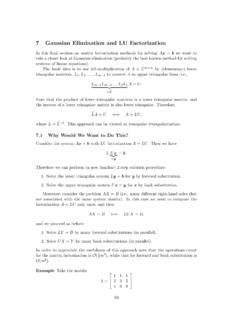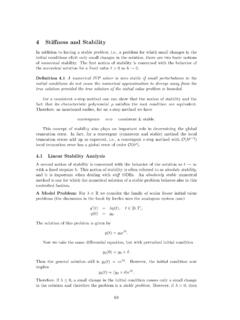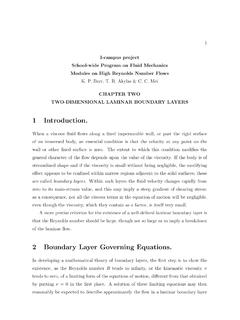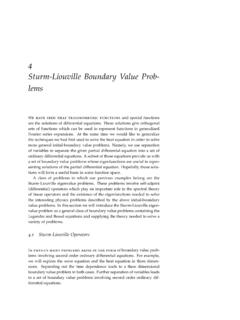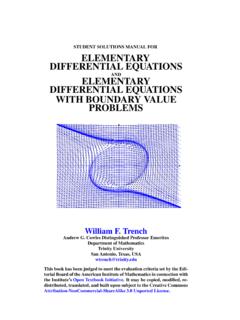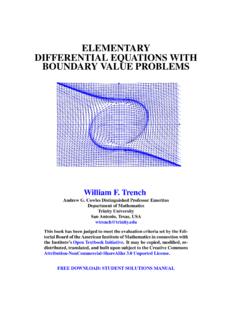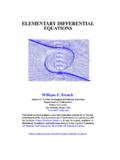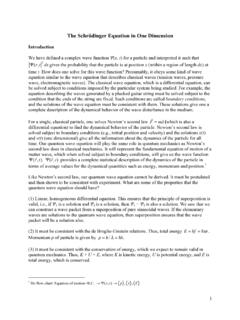Transcription of MATH 461: Fourier Series and Boundary Value Problems ...
1 MATH 461: Fourier Series and Boundary ValueProblemsChapter III: Fourier SeriesGreg FasshauerDepartment of Applied MathematicsIllinois Institute of TechnologyFall 461 chapter 31 Outline1 Piecewise Smooth Functions and Periodic Extensions2 Convergence of Fourier Series3 Fourier Sine and Cosine Series4 Term-by-Term Differentiation of Fourier Series5 Integration of Fourier Series6 Complex Form of Fourier 461 chapter 32 Piecewise Smooth Functions and Periodic ExtensionsDefinitionA functionf, defined on[a,b], is piecewise continuous if it iscontinuous on[a,b]except at finitely many points. If bothfandf arepiecewise continuous, thenfis called piecewise means that the graphs of f and f may have only finitely manyfinite 461 chapter 34 Piecewise Smooth Functions and Periodic 461 chapter 35 ExampleThe functionf(x) =|x|defined on <x< ispiecewise smoothsincefis continuous throughout theinterval,andf is discontinuous only atx= functionf(x) ={x2, <x<0x2+1,0 x< ispiecewise smooth since bothfandf are continuous except atx= Smooth Functions and Periodic 461 chapter 36 ExampleThe functionf(x) ={ ln(1 x),0 x<11,1 x<2isnot piecewise continuous (andtherefore also not piecewisesmooth) sincelimx 1 f(x) =limx 1 ln(1 x) = , ,fhas an infinite jump atx= Smooth Functions and Periodic ExtensionsPeriodic ExtensionIffis defined on[ L,L], then its periodic extension, defined for allx, isgiven byf(x) =.}}
2 F(x+2L), 3L<x< L,f(x), L<x<L,f(x 2L),L<x<3L,f(x 461 chapter 37 Piecewise Smooth Functions and Periodic ExtensionsExampleFigure: Plot offforf(x) =1 xL 461 chapter 38 Piecewise Smooth Functions and Periodic ExtensionsExampleFigure: Plot offforf(x) ={(x+L)2, L x 461 chapter 39 Convergence of Fourier SeriesEven though we have used Fourier Series to represent a given functionfwithin our separation of variables approach, we have never madesure that these Series actually , even if we can assure convergence, how do we know thatthey converge to the functionf?RemarkThis should not come as a total surprise, since for power Series wealso had to determine the interval (or radius) of 461 chapter 311 Convergence of Fourier SeriesUsing a more precise notation, all we can say isf(x) a0+ n=1[ancosn xL+bnsinn xL], , we canassociate withfthis Fourier Series ,but notfis equal to this Fourier Fourier coefficients off, on the other hand, are never in are given bya0=12L L Lf(x)dxan=1L L Lf(x)cosn xLdx,n=1,2.)}
3 Bn=1L L Lf(x)sinn 461 chapter 312 Convergence of Fourier SeriesWhat we need isTheorem ( Fourier Convergence Theorem)If f is piecewise smooth on[ L,L], then the Fourier Series of ,1at those points x where the periodic extensionf of f is continuous,the Fourier Series of f converges tof(x)and2at jump discontinuities of the periodic extension, the Fourier seriesconverges to12[f(x ) +f(x+)], , the average of the left and right limits at the that (2) actually includes (1) since12[f(x ) +f(x+)]=12[f(x) +f(x)]=f(x)providedf is continuous at x 461 chapter 313 Convergence of Fourier proof of this theorem is not contained in [Haberman] and goesbeyond the scope of this course. It can be found in [Pinsky,Section ] or [Brown & Churchill, Section 19].The proof requires the Dirichlet kernelDN(x) =12+N n=1cosnx=sin(N+12)x2 sinx2as well as a careful analysis of one-sided calculations for Gibbs phenomenon below gives a flavor 461 chapter 314 Convergence of Fourier SeriesRemarkThe theorem above is about pointwise convergence of Fourier classical harmonic analysis there are also theorems about otherkinds of convergence of Fourier Series , such asuniform convergence orconvergence in the these see, , [Brown & Churchill, Pinsky].
4 We will talk about convergence in the mean in chapter 5, and theGibbs phenomenon below is evidence that uniform convergence is notguaranteed for general functions f 461 chapter 315 Convergence of Fourier SeriesExampleConsider the functionf(x) ={1, L x<02,0<x LThe Fourier Series off,a0+ n=1[ancosn xL+bnsinn xL], isrepresented by the following 461 chapter 316 Convergence of Fourier SeriesExample (cont.)RemarkEven if we know that the Series converges, we havef(x) =its Fourier Series only for x ( L,L)(and provided f iscontinuous at x ).At all other values of x the Fourier Series equals the periodicextension of f ,except at jump discontinuities, where it equals the average are the Fourier coefficients for this 461 chapter 317 Convergence of Fourier SeriesExample (cont.)a0=12L L Lf(x)dx=12L[ 0 L1 dx+ L02 461 chapter 318 Convergence of Fourier SeriesExample (cont.)an=1L L Lf(x)cosn xLdx=1L[ 0 Lcosn xLdx+2 L0cosn xLdx]=1L[ L Lcosn xLdx =0+ L0cosn xLdx]=Ln L[sinn 461 chapter 319 Convergence of Fourier SeriesExample ((cont.))]]}
5 Bn=1L L Lf(x)sinn xLdx=1L[ 0 Lsinn xLdx+2 L0sinn xLdx]=1L[ L Lsinn xLdx =0+ L0sinn xLdx]= Ln L[cosn xL]L0= cosn n +cos 0n =1 ( 1)nn ={0,neven2n 461 chapter 320 Convergence of Fourier SeriesExample (cont.)Summarizing, we have found that the functionf(x) ={1, L x<02,0<x Lhas Fourier seriesf(x) 32+ n=11 ( 1)nn sinn xL=32+ k=12(2k 1) sin(2k 1) 461 chapter 321 Convergence of Fourier SeriesExample (cont.)Figure: Plot of 10-term Fourier Series approximationf(x) =32+10 k=12(2k 1) sin(2k 1) xL(red) together with graph 461 chapter 322 Convergence of Fourier SeriesThe Gibbs PhenomenonIn order to understand the oscillations of the previous plots, and inparticular the overshoot, we consider an almost identical function:f(x) ={ 1, x<01,0<x with truncated Fourier seriesf2N(x) =f2N 1(x) =N n=12(1 ( 1)n)n sinnx=N k=14 sin(2k 1)x2k 1 RemarkCompared to the previous example, the sines are simpler since L= ,and we have a vertical shift by a0=0and a vertical stretching so thatbn=21 ( 1)nn ={0,n even4n ,n 461 chapter 323 Convergence of Fourier SeriesGibbs Phenomenon (cont.)}}}}
6 To find the overshoot at the jump discontinuity we look at the zeros ofthe derivative of the truncated Fourier Series (to locate its maxima), ,f 2N 1(x) =4 N k=1cos(2k 1)x=4 [cosx+cos 3x+..+cos(2N 1)x]To find the zeros of this function we multiply both sides by sinx, ,sinxf 2N 1(x) =4 [sinxcosx+sinxcos 3x+..+sinxcos(2N 1)x]Using the trigonometric identity sinxcoskx=sin(k+1)x sin(k 1)x2we getsinxf 2N 1(x) =2 [(sin 2x sin 0) + (sin 4x sin 2x) +..+ (sin 2Nx sin(2N 2)x)]=2 sin 461 chapter 324 Convergence of Fourier SeriesGibbs Phenomenon (cont.)Now,sin 2Nx=0 if 2Nx= , 2 ,.., 2N .The maximum overshoot occurs atx= 2 Nand its Value isf2N 1( 2N)=4 N k=1sin(2k 1) 2N2k 1=2 2N NN k=1sin(2k 1) 2N2k 1=2 N k=1sin(2k 1) 2N(2k 1) 2N 461 chapter 325 Convergence of Fourier SeriesGibbs Phenomenon (cont.)If we interpretN k=1sin(2k 1) 2N(2k 1) 2N Nas a partial Riemann sum with x= Nand midpointsx = 2N,3 2N,..,(2N 1) 2 Nfor the partition 0, N,2 N,..,(N 1) N, of[0, ]thenf2N 1( 2N) 2 0sinxxdxforN.
7 This integral can be evaluated numerically to getf2N 1( 2N) 461 chapter 326 Convergence of Fourier SeriesGibbs Phenomenon (cont.)Since the actual size of the jump discontinuity is 2, we have anapproximately 9% overshoot. This is true in general [Pinsky, p. 60]:TheoremIf f is piecewise smooth on( , )then the overshoot of the truncatedFourier Series of f at a discontinuity x0(the Gibbs phenomenon) isapproximately 9% of the jump, , [f(x0+) f(x0 )].RemarkThe Gibbs phenomenon was actually discovered by HenryWilbraham in 1848. Gibbs was just more famous, published in a betterjournal (50 years later), and built in some mistakes perhaps drawingmore attention to his work (for further discussion see [Trefethen, chapter 461 chapter 327 Fourier Sine and Cosine SeriesWe begin by reviewing the concepts of odd and even functions:Definitionfis an odd function iff( x) = f(x)for allxin the domain graph of an odd function is symmetric about the an odd function we have L Lf(x)dx=0.)]
8 L Lf(x)dx= 0 Lf(x) u= xdu= dxdx+ L0f(x)dx= 0Lf( u) = f(u)du+ L0f(x)dx= L0f(u)du+ 461 chapter 329 Fourier Sine and Cosine SeriesDefinitionfis an even function iff( x) =f(x)for allxin the domain graph of an even function is symmetric about the y an even function we have L Lf(x)dx=2 L0f(x)dx,which can be shown similarly to the analogous property for 461 chapter 330 Fourier Sine and Cosine SeriesLet s consider the Fourier Series of an odd functionf(x) a0+ n=1[ancosn xL+bnsinn xL]witha0=12L L Lf(x) odddx=0,an=1L L Lf(x) oddcosn xL even odddx=0bn=1L L Lf(x) oddsinn xL odd evendx=2L L0f(x)sinn xLdx(=Bn)Therefore,f(x) n=1 Bnsinn xL, , the Fourier Series is automatically a Fourier sine 461 chapter 331 Fourier Sine and Cosine SeriesWhat does the Fourier sine Series offconverge to?TheoremIf f is piecewise smooth on[0,L], then the Fourier sine Series of ,1at those points x where the odd periodic extension of f iscontinuous, the Fourier sine Series converges to the odd periodicextension and2at jump discontinuities of the odd periodic extension, the Fouriersine Series converges to the average of the left and right limits atthe 461 chapter 332 Fourier Sine and Cosine SeriesExampleFigure: Plot of odd periodic extension off(x) =1 461 chapter 333 Fourier Sine and Cosine SeriesRemarkEven if f is not an odd function, it may still be necessary to represent itby a Fourier sine heat equation problem u t(x,t) =k 2u x2(x,t),0<x<L,t>0u(0,t) =u(L,t) =0u(x,0) =cos xLhas sines as eigenfunctions, so we need to find the Fourier sine seriesexpansion off(x) =cos 461 chapter 334 Fourier Sine and Cosine SeriesExample (cont.)
9 We knowu(x,t) = (x)G(t), with eigenvalues n=(n L)2,n=1,2,3,..and eigenfunctions n(x) =sinn xLas well asGn(t) =e (x,t) = n=1 Bnsinn xLe k(n L)2tandu(x,0) = n=1 Bnsinn xL!=cos 461 chapter 335 Fourier Sine and Cosine SeriesExample (cont.)In HW you should showaBn=2L L0cos xLsinn xLdx={0,nodd4n (n2 1),nevenTherefore, lettingn=2k(even), we havecos xL= k=18k (4k2 1)sin2k xLand the equality is true for 0<x<L(since the cosine equals its oddperiodic extension there).Forx=0 andx=Lthe Series is zero (which is equal to the averagejump of the cosine function there).aRemember that we established the orthogonality of sine and cosine onlyon[ L,L], not 461 chapter 336 Fourier Sine and Cosine SeriesConsider the Fourier Series of an even functionf(x) a0+ n=1[ancosn xL+bnsinn xL]witha0=12L L Lf(x) evendx=1L L0f(x)dx(=A0)an=1L L Lf(x)cosn xL evendx=2L L0f(x)cosn xLdx(=An)bn=1L L Lf(x)sinn xL odddx=0 Therefore,f(x) A0+ n=1 Ancosn xL, , the Fourier Series is automatically a Fourier cosine 461 chapter 337 Fourier Sine and Cosine SeriesTheoremIf f is piecewise smooth on[0,L], then the Fourier cosine Series of ,1at those points x where the even periodic extension of f iscontinuous, the Fourier cosine Series converges to the evenperiodic extension and2at jump discontinuities of the even periodic extension, the Fouriercosine Series converges to the average of the left and right limitsat the that jump discontinuities are possible only for0<x<L, , if fitself had jump discontinuities.}
10 The even periodic extension cannothave any jumps at x=0or x= 461 chapter 338 Fourier Sine and Cosine SeriesExampleFigure: Plot of even periodic extension off(x) 461 chapter 339 Fourier Sine and Cosine SeriesExampleFind the Fourier cosine Series expansion of the functionf(x) ={1,0 x<L20,L2 x Land sketch its : Plot of Fourier cosine seriesf(x) a0+ n=1ancosn 461 chapter 340 Fourier Sine and Cosine SeriesExample (cont.)Let s compute the Fourier cosine coefficients:A0=1L L0f(x)dx=1L[ L/201 dx+ LL/20 461 chapter 341 Fourier Sine and Cosine SeriesExample (cont.)An=2L L0f(x)cosn xLdx=2L[ L/20cosn xLdx+ LL/20 cosn xLdx]=2 LLn [sinn xL]L/20=2n sinn 2={0,n=2keven2(2k 1) ( 1)k+1,n=2k 1 oddThereforef(x) 12+ k=12( 1)k+1(2k 1) cos(2k 1) xLNote that equals = for allx 461 chapter 342 Fourier Sine and Cosine SeriesEven and odd parts of functionsTheoremAny function f can be written as the sum of an even and an oddfunction:f(x) =12[f(x) +f( x)] :=fe(x)+12[f(x) f( x)] :=fo(x) ,feis evenfe( x) =12[f( x) +f(x)]=fe(x),andfois oddfo( x) =12[f( x) f(x)]= 12[f(x) f( x)]= 461 chapter 343 Fourier Sine and Cosine SeriesNow, the Fourier Series for an arbitrary functionfis given byf(x) a0+ n=1ancosn xL even+ n=1bnsinn xL oddwith Fourier coefficientsa0=12L L Lf(x)dx,an=1L L Lf(x)cosn xLdx,bn=1L L Lf(x)sinn the other hand, n=1bnsinn xLis a Fourier sine , it is the Fourier sine Series offo, not off!]}}
